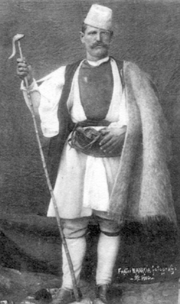Aromanians
|
|
Macedoromeno.gif
Aromanians (also called: Macedo-Romanians in Romania or Vlachs in most other countries; in Aromanian they call themselves arumāni, armāni or aromāni) are a people living throughout the southern Balkans, especially in northern Greece, Albania, the Former Yugoslav Republic of Macedonia, Serbia, and Bulgaria; their number is estimated at about one or two million.
They speak a Romance language called Aromanian which is a similar language to Romanian. Due to the common language foundation, historians believe that the language link with Romanian was interrupted between the 7th and 9th century, after the most important features of the language were formed.
| Contents |
Name
The name Aromanian, just as Romanian derives directly from Latin "Romanus", through regular sound changes. Adding "a" in front of certain words is a feature of the Aromanian language.
Vlachs was a term used in the Medieval Balkans, as an exonym for all the Romanic people, but nowadays, it is commonly used only for the Aromanians and Meglenites, the Romanians being named Vlachs only in historical context. See also: Etymology of Vlach.
Vlachs_Serres.jpg
Aromanians in Greece
In Greece, they are not recognised as an ethnic minority, instead being considered Latin-speaking Greeks. Their origins are disputed. The Romanian hypothesis contends that Aromanians came to northern Greece from the Danube region; the opposing Greek theory is that they descend from the Romanised local population. It is however clear that until the 9th century, Romanians and Aromanians spoke the same eastern variant of Vulgar Latin). Despite the Romanian connection, most Aromanians in Greece today identify as Greeks and heirs to the Byzantine tradition. It is interesting to note that Greek-speakers have also called themselves Romans well into modern times in reference to the Greek-speaking East Roman or Byzantine Empire, which called itself Romania several centuries before the modern Balkan nation-state of the same name was conceived. It is in this context that Aromanians played an important role in the Greek War of Independence against the Ottoman Empire and generally in Greek society. Prominent Aromanians in Greece have included Ioannis Kolettis, the first prime minister, Evangelos Averof, minister of Defence during the Balkan Wars and Konstantinos Krystallis, the famous poet.
The pressure on Aromanians to assimilate can be traced back to the 18th century, when assimilation efforts were encouraged by the Greek missionary Kosmas Aitolos (1714-1779) who taught that Aromanians should speak Greek because as he said it's the language of our Church and established over 100 Greek schools in northern and western Greece.
The Aromanians, mostly herdsmen living in high mountain areas (especially in the Pindus area) in northern Greece never had a complete education in their language. Although Romania subsidised schools until 1948, the communist regime ended all links, and there is currently almost no education for Aromanian children in their mother tongue. It seems to be just a matter of time until they are completely assimilated into Greek society.
The European Parliamentary Assembly examined a report on the Aromanians in 1997, and adopted a recommendation that the Greek government should do whatever is necessary to respect their culture and facilitate education in Aromanian and its use in schools, churches and the media. However, efforts to promote the Aromanian language in Greece have often been controversial amongst the Aromanians themselves, many of whom vehemently reject any idea of an officially-sanctioned distinction between them and other Greeks. On the other hand, there is a small but vocal minority within the community which strongly supports such efforts. On a visit to Metsovo, Epirus in 1998, Greek President Costis Stephanopoulos called on Vlachs to speak and teach their language, but little has been done in practical terms since then.
Aromanians in Albania
The second largest Aromanian community lives in Albania, counting between 100,000 and 200,000 people. There is currently no education in their native language, but unlike in Greece, the Vlachs are a recognised national minority in the Albanian constitution, despite the Greek view that the Vlachs of Albania form part of the wider Greek minority.
Aromanians in the Former Yugoslav Republic of Macedonia
Although not very numerous (about 20,000) in the Former Yugoslav Republic of Macedonia, official government data lower their number to 8,467. The Aromanians are represented in parliament and enjoy ethnic, cultural, linguistic and religious rights and the right to education in their language.
They have also received support from the Romanian government which made recognition of the country's independence conditional on the extension of rights to the Aromanians.
Aromanians in Romania
Since the Middle Ages, due to the Turkish occupation and the destruction of their cities, such as Moscopole, many Aromanians fled their homeland in the Balkans to settle the Romanian principalities of Wallachia and Moldavia, which had a similar language and a certain degree of autonomy from the Turks. These isolated cases were assimilated by the majority culture.
In 1860 the Romanian government opened almost 100 schools in Greece and the Ottoman territories of Macedonia and Albania in an attempt to inculcate a sense of modern Romanian national identity in a population which historically identified with the Byzantine tradition.
In 1925, 47 years after Dobruja was unified with Romania, King Carol II of Romania gave the Aromanians land to settle in this region. The result was that currently about 50,000 (15%) of the population of Dobruja speaks the Aromanian dialect. They do not consider themselves an ethnic minority, but a cultural minority.
See also
External links
- The Folklore Association of Vlahs (Armani) in Veria (http://www.vlahoi.gr)
- vlachophiles.net: Aromanian - The Vanishing Tribes (http://www.vlachophiles.net)
- farsarotul.org: The Society Farsarotul (http://www.farsarotul.org)
- Studies on the Vlachs (http://www.vlachs.gr), by Asterios Koukoudis
- The Vlachs of Greece and their Misunderstood History (http://www.farsarotul.org/nl26_1.htm), by Helen Abadzide:Aromunen

